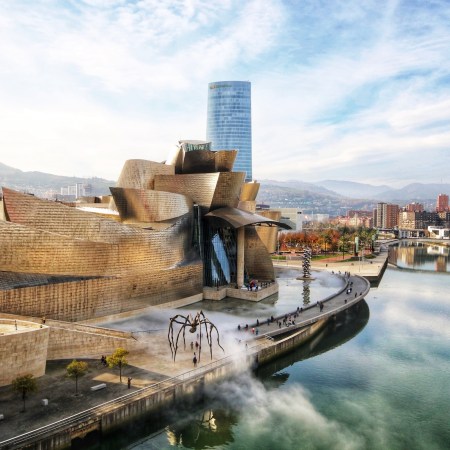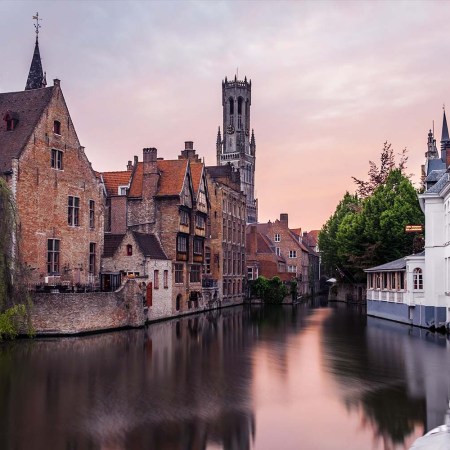Those who found the deaths of certain Game of Thrones characters too fantastical have likely never been to Slovenia’s Predjama Castle, where the robber baron Erasmus of Lueg met his end one evening in the year 1483.
Erasmus was high-born, a son to the imperial governor of Trieste, which was then a crucial seaport for both the Habsburg Empire and the Venetian Republic. He was — in modern parlance — a real pain in the neck. The burgrave fell in love with the daughter of an archduke who wanted him dead; he led a series of Robin Hood-esque “robbery marches,” in which he and his other tax-exempt buds stole riches and distributed them to the poor peasants living in the Slovenian hills; and to top it all off, he overreacted at a meeting of the Vienna Court and killed a man…who happened to be the commander of the Habsburg imperial army, and a relative to the Holy Roman Emperor.
That might’ve been a good time to go into hiding, but instead, Erasmus began a campaign of attacking villages under the umbrella of Habsburg rule. He…really wanted his money’s worth. Eventually, he holed up at Predjama, which, at the time was just a couple hundred years old. As far as pillaging yourself into a corner goes, you can’t ask for a much better fortress. The medieval castle was built in the foothills of the Julian Alps, a southern portion of the famous mountain range, named for Julius Caesar and known for its high concentration of limestone.
And all that limestone means the area is highly karstic — its topography is rife with sinkholes, underground streams, and caverns formed by hundreds of millions of years of rivers and raindrops rushing or pitter-pattering into chalky, malleable rock. To this day, Predjama is situated at the mouth of a cave that the planet began to form way back in the Mesozoic Era. It came in handy when Erasmus’ adversaries laid siege to the castle. Their only option was the front door, where Predjama had an array of clever vantage points from which to shoot or drop sharp projectiles. Winters were harsh though, even this close to the Mediterranean, so the Habsburgs figured they’d just wait until Erasmus starved.
The irascible upstart responded by occasionally tossing satchels of meat and horns of fruit from behind the castle walls, to taunt the whole lot of them. Somehow, he had more than enough food. While touring Predjama earlier this summer, I was able to see for myself how Erasmus survived so long. There’s a secret passageway behind the castle, built into the cave, which leads interested parties to the valley on the other side of the mountain. Erasmus was content to play at this game as long as the Habsburgs were willing to waste their time and energy.
Until one night he was blown to bits by a cannonball while sitting on the toilet. The castle’s privy was detached from the center of the castle, which had been reinforced several times over to protect the throne room and sleeping quarters. By comparison, its walls were extremely thin. Erasmus had a disgruntled aide to thank for dying with his bathrobe around his ankles. The man reportedly sold him out to the attackers, and lit a candle to alert them as Erasmus trotted out to handle his pre-bed business. He was later killed, too. No one likes a traitor.

Obviously, there are hundreds of castles in Europe, with thousands of similar, made-for-your-favorite-podcast yarns. Scintillating history or not, Slovenia is never top of mind when Americans decide to put aside dollars and vacation days to fly across the Atlantic. Whether you want to brush shoulders with locals and sit in a plaza with an espresso and a cold beer (Anthony Bourdain stuff) or gander at the tiny beds of old lords and perhaps get lucky enough to see a torture chamber (Rick Steves stuff), there are usually a dozen countries on the continent that would make the list before the Republic of Slovenia.
Why is that, though? Slovenia’s got plazas, after all. And Predjama’s home to one hell of a torture chamber. It’s directly over a cave that’s home to a colony of bats. There are vents through which captives would’ve heard the screech of the animals and the trickle of water; the audio cassette that each visitor receives upon entering the castle pumps in gratuitous moaning. It’s not difficult to imagine someone’s mind unraveling within the damp castle. That’s especially true if you have the room to yourself as I did — there wasn’t another tourist in sight.
Unlike immediate neighbors Italy (unsurprisingly: top three in Europe for international tourists every year), and Croatia (an emerging powerhouse, with 60 million visitors arriving annually before the pandemic), Slovenia isn’t a tourist destination. Tourism accounts for less than 7% of its economy, and Slovenia is continually ranked among the 20 least-visited European nations, alongside names like Latvia and Lichtenstein. As I traveled around Slovenia for a couple days this summer, I tried to make sense of the lack of international interest in visiting the country. One theme revealed itself over and over again: contradictions.
Slovenia is full of them. It’s a young nation with an ancient history. It’s free, peaceful and progressive but many still associate its name with communism and war. And more than perhaps any other member of the European Union, it represents a bizarre amalgamation of Northern, Southern, Western and Eastern Europe.
Along its coastline — yes, there is a Slovene Riviera, with 29 miles of access to the Adriatic — the weather is warm and windy. Mediterranean. There are olive trees, from which families make small-batch olive oil to sell to their friends. A “mañana mentality” persists. They love this Spanish word and use it often; anything that can be left for tomorrow will be left for tomorrow. But further inland, along the new highway and up over the mountains, there’s a shift to continental weather, and a flip in mindset to the economic pragmatism that powers the nations past its northern borders. Slovenia builds cars for Germany and France. Its pharmaceutical exports rival those of Sweden and Canada.

Even before the fall of the Soviet Union in 1991 — which saw Slovenia win its independence, the rest of Yugoslavia fracture into Bosnia and Herzegovina, Croatia, Macedonia, Montenegro, Serbia, and a decade of the heartbreaking Yugoslav Wars — Slovenia was a bit of a mystery.
I spoke with a guide who grew up in Koper, Slovenia, in the 1970s. He remembers relative freedom of movement as a child. Yugoslavia was a socialist state, make no mistake, and helmed for 27 years by Josip Broz Tito, an autocrat who regularly sent dissenters to a barren island prison called Goli Otok. But parts of the federation, like Slovenia, were relatively decentralized and experienced periods of liberalization. My guide remembers teachers pointing to where they lived on a map — the West was blue, the Soviet Union was red, but Slovenia was purple. On weekends, the coastal road to Trieste, Italy was backed up for miles. The Slovenians wanted candy and blue jeans.
You’d hardly be able to tell that bombs were exploding in Dalmatia just 20 years ago, while sailing in Zadar or partying in Hvar today. Croatia — and Montenegro as well, where tourism accounts for a quarter of the country’s GDP — has leveraged its recovered coastline to reel in the sort of tourists who’d normally pilgrimage to Amalfi or the Greek Islands. That prescription may have taken a hit during the pandemic, but in the long run, the strategy is sound. Perhaps Albania will be “discovered” by travelers next. Wedged between Montenegro and Greece, it has 280 miles of coastline, and currently welcomes less than four million tourists per year.
Slovenia will likely continue on a more subtle path. Remolding its GDP around tourism would be a waste of resources, considering how successful it’s been in wealthier, more sustainable sectors. And as for those who make the trek down anyway? They’ll find, as I did, that Slovenia’s penchant for contradictions isn’t a weakness; it’s actually the unheralded nation’s greatest asset. Why settle for a a single, digestible identity when you can offer a little bit of everything?

In the northeast, along the Hungarian border, there’s the 25,000-acre Podravje wine region, where, for millennia, soft carbonate rock has created fertile brown soils that accommodate a vibrant viticulure. The Romans grew grapes here, and every year, the Slovenians stage a festival to celebrate the oldest grape vine in the world. In the southwest, meanwhile, black summer truffles grow between April and October, while white truffles grow between September and January. Truffle “hunting” was only legalized in 2011, but the Istrian region has its experts — of the human and canine varieties.
Outdoor pursuits are popular too; one might assume that Slovenian athletes who perform well at international events honed their skills by making use of nearby playgrounds. (Their bikers might’ve traveled to Italy, their skiers into Switzerland, and so forth.) But it’s rare to drive a hill, any hill, in Slovenia, and not see a summiting cyclist. Plus, for a country with such clear views of the sea, there are at least a dozen reputable ski resorts in the Julian Alps. Cerkno Ski Resort, in the northwest of the country, and only an hour’s drive from the capital, Ljubljana, is usually recognized as the best.
Sloveian is small, which makes it easy to see over a couple days, and even easier to finagle into a larger tour of the Adriatic. Make sure to visit the ever-evolving capital, or take a boat out to Lake Bled, the site of yet another medieval castle. This one doesn’t abut a cavern; it’s on an island in the middle of a 100-foot reservoir, which has hosted the World Rowing Championships on four different occasions. And once you’ve had enough of Slovenia, you can visit Trieste, where James Joyce made his home for years, continue further south to Dubrovnik, or even take a six-hour train to Vienna (for $25, no less). From there, you’ve got the entire continent at your fingertips.
For all the country’s “master of none” charm, it does have one untouchable, mic drop attraction: Postojna Cave Park, not far from Predjama Castle, which is one of the largest cave systems in Europe. I spent two fever-dream hours down there, traipsing through the 50°F cold (it was 95°F upstairs, so they told me to rent a robe; I refused and shivered like an idiot), gawking at stalagmites, stalactites, a cavernous “room” where the Slovenian church holds a hauntingly beautiful nativity scene each Christmas, a bridge built by Russian prisoners in 1916, the world’s only “cave post office,” and most trippy of all, the olm, a ruler-sized amphibian that looks like someone skinned a baby dragon, which feeds on snails and lives up to 100 years entirely in the dark.
In 1818, a local lamplighter named Luka Čeč was the first to discover the full extent of the Postonjna cave system. He reportedly raved at the time: “Here is a new world, here is paradise!” The quote stuck with me as I ferried away from Slovenia; paradise can be more than a palm tree. It’s a reveling in a place’s contradictions, its mysteries and its many things new and unknown — dark caves and torture chambers included.
For more travel news, tips and inspo, sign up for InsideHook's weekly travel newsletter, The Journey.






















